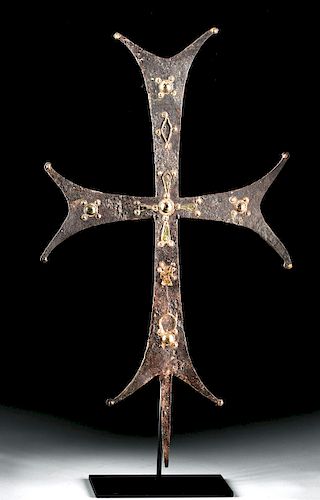Byzantine Iron w/ Brass Military Processional Cross
Lot 109
About Seller
Artemis Fine Arts
686 S Taylor Ave, Ste 106
Louisville, CO 80027
United States
Selling antiquities, ancient and ethnographic art online since 1993, Artemis Gallery specializes in Classical Antiquities (Egyptian, Greek, Roman, Near Eastern), Asian, Pre-Columbian, African / Tribal / Oceanographic art. Our extensive inventory includes pottery, stone, metal, wood, glass and textil...Read more
Estimate:
$5,500 - $8,000
Absentee vs Live bid
Two ways to bid:
- Leave a max absentee bid and the platform will bid on your behalf up to your maximum bid during the live auction.
- Bid live during the auction and your bids will be submitted real-time to the auctioneer.
Bid Increments
| Price | Bid Increment |
|---|---|
| $0 | $25 |
| $300 | $50 |
| $1,000 | $100 |
| $2,000 | $250 |
| $5,000 | $500 |
| $10,000 | $1,000 |
| $20,000 | $2,500 |
| $50,000 | $5,000 |
| $100,000 | $10,000 |
| $200,000 | $20,000 |
About Auction
By Artemis Fine Arts
Sep 26, 2019
Set Reminder
2019-09-26 10:00:00
2019-09-26 10:00:00
America/New_York
Bidsquare
Bidsquare : Exceptional Day 1: Antiquities & Asian Art
https://www.bidsquare.com/auctions/artemis-gallery/exceptional-day-1-antiquities-asian-art-4437
Day 1 of an important 2-day auction featuring exceptional, museum-worthy examples of Egyptian, Greek, Etruscan, Roman, Viking, Russian, Near Eastern, as well as Asian Art from China, Japan, Thailand, Vietnam, Burma and India. Artemis Fine Arts info@artemisfinearts.com
Day 1 of an important 2-day auction featuring exceptional, museum-worthy examples of Egyptian, Greek, Etruscan, Roman, Viking, Russian, Near Eastern, as well as Asian Art from China, Japan, Thailand, Vietnam, Burma and India. Artemis Fine Arts info@artemisfinearts.com
- Lot Description
Ancient Near East, Holy Land, Byzantine Empire, ca. 10th to 12th century CE A beautiful cast-iron cross created for display during Byzantine military processions. The cross displays three projecting arms and a lengthy body, each with flared terminals and knob-capped tips. The obverse face boasts a myriad of brass appliques including encircled hemispheres, thin diamonds, teardrop forms, and a central orb-filled ring. The four drop-form shapes combined with the central hemisphere symbolically represent the five wounds that Christ suffered during the crucifixion. The lower terminus was to be inserted or attached to a processional staff to raise it above the heads of parade participants and onlookers alike. While the verso is unadorned, the entire piece exhibits wonderful patina. Size: 12.75" W x 22.25" H (32.4 cm x 56.5 cm); 23.5" H (59.7 cm) on included custom stand.
The Byzantine Empire was established in the fourth century CE when the Emperor Constantine, also known as Saint Constantine, Christianized the Roman Empire and pronounced the city of Constantinople in Byzantium as the capital. The visual culture of this era demonstrates a synthesis of classical Greek, Roman, and Christian influences.
A very similar example with more ornate brass appliques hammered for GBP 18,500 ($24,147.18) at Christie's, London "Icons and Artefacts from the Orthodox World" Auction (sale 7542, November 26, 2007, lot 45): https://www.christies.com/lotfinder/lot/a-processional-cross-byzantine-10th-12th-century-4999979-details.aspx?from=searchresults&intObjectID=4999979&sid=d7eb2095-a8d4-4aca-8ec5-d8c3cf9b2909
Provenance: private East Coast, USA collection; ex-Madame Frances Artuner collection, Belgium, acquired in the 1960s
All items legal to buy/sell under U.S. Statute covering cultural patrimony Code 2600, CHAPTER 14, and are guaranteed to be as described or your money back.
A Certificate of Authenticity will accompany all winning bids.
We ship worldwide and handle all shipping in-house for your convenience.
#146232Repairs to one corner of each of the four arms, with resurfacing and overpainting along break lines. Slight bending to overall form, with abrasions and nicks to arms, terminus, and brass appliques, and light encrustations. Light earthen deposits and nice patina throughout.Condition
- Shipping Info
-
All shipping is handled in-house for your convenience. Your invoice from Artemis Gallery will include shipping calculation instructions. If in doubt, please inquire BEFORE bidding for estimated shipping costs for individual items.
-
- Buyer's Premium



 EUR
EUR CAD
CAD AUD
AUD GBP
GBP MXN
MXN HKD
HKD CNY
CNY MYR
MYR SEK
SEK SGD
SGD CHF
CHF THB
THB














